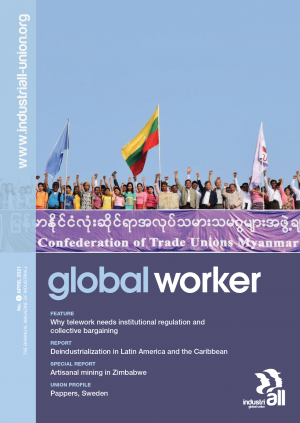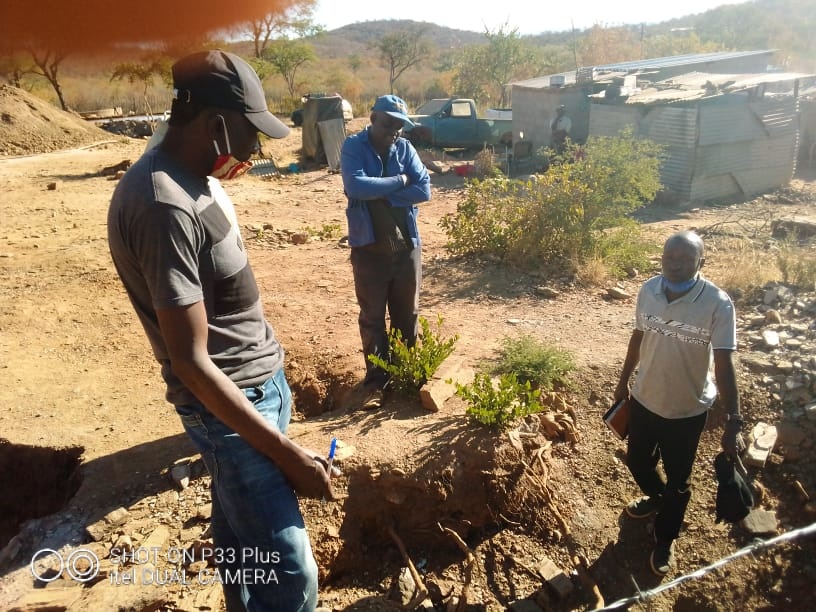6 May, 2021Campaigns by trade unions, civil society organizations and mine affected communities for the formalization of artisanal and small-scale mining (ASM) are meant to end the deadly working conditions of the miners in Zimbabwe. In addition, formalization will introduce decent working conditions.
SPEACIAL REPORT From Global Worker no. 1 May 2021 | |
 | Country: Zimbabwe Theme: Zimbabwe’s artisanal and small-scale mining |
Campaigns by trade unions, civil society organizations and mine affected communities for the formalization of artisanal and small-scale mining (ASM) are meant to end the deadly working conditions of the miners in Zimbabwe. In addition, formalization will introduce decent working conditions.
Hundreds of artisanal and small-scale miners in the country are dying in flooded and collapsing mines which are trapping miners underground. Rock falls often block escape routes and toxic gases suffocate the miners in poorly ventilated mines. Most rescue operations carried out by the government’s ill-equipped teams are never completed, and only a few miners are rescued before the operations are abandoned.
Sadly, some mines where accidents have happened are now grave sites of the mainly youthful miners. The mine accidents in the last few years include Ran Mine, Bindura where an old derelict gold mine shaft collapsed on 6 November 2020. Only six miners were rescued and 24 trapped underground when the rescue mission ended. At Cricket and Silvermoon Mine in the Battlefields area near Kwekwe over 40 miners died. Most of the accidents have happened at mines that were no longer operational and whose mining licences were in dispute.
Commenting on the country’s quick abandonment of rescue operations, the Parliament of Zimbabwe says there is no compassion in the way the country deals with artisanal miners’ deaths with rescuers failing to save miners from shallow depths of about 60 metres.
Zimbabwe’s labour laws allow for health and safety in the mines and the country has also signed the International Labour Organization Convention 176 on Safety and Health in Mines. But these legal frameworks are less useful in an informal working environment that is sometimes controlled by syndicates and gangs.
With no other source of income, over one million miners, or 14 per cent of the country’s labour force, continue to look for minerals, especially gold, to eke out a living. The vicious cycle continues as accidents in the unsafe mines continue to claim the lives of the workers. With the country’s decades long economic crisis, unemployment remains high with over two million people living in poverty. Child labour is common along rivers, with some children dropping out of school to pan for gold.
Terrance Sakala (25) an artisanal miner working at a small scale mine with seven other workers near Kadoma, says:
“My working day begins by pumping water from the 30 metre deep mine using a submersible water pump and waiting for four hours before we drill three holes into the earth using a jack hammer. After that, we put explosives and blast and wait for another four hours before we go into the mine to scoop the ore. We get paid weekly, but this depends on the gold that we get after milling. When there is no gold; there is no money. In a good week you can get as much as US$500 but in a bad one the amount can be US$100 or nothing. We live in hope and faith. Artisanal mining is about endurance. This is not large-scale industrial mining.”
The Zimbabwe Auditor General’s report confirms that there is non- compliance with occupational health and safety in ASM. This is worsened by situations where the mining takes place at sites where there are ownership disputes and mining may be considered by the authorities as unlawful. There have also been incidents of violence when knife wielding gangs attacked some artisanal miners and communities in violent clashes over land use.
Unions in Zimbabwe have long identified the risks of ASM as unsafe and poorly ventilated pits. Further, the shafts and tunnels are prone to collapse and flooding, especially after heavy rains. There is also lack of personal, protective equipment and exposure to dust. The miners are also exposed to other risks from hard labour as the work involves digging with picks and shovels repetitively over long hours. Most miners or their employers cannot afford to buy mining equipment and machinery. There is also exposure to hazardous substances such as mercury.
On the increasing calls for formalization of ASM, Justice Chinhema, general secretary, Zimbabwe Diamond and Allied Minerals Workers Union, says:
“As a union representing the interests of mine workers across the country, we urge the government to advance the rights of artisanal and small-scale miners by giving them mining concessions and improved access to mineral rights. The lack of such concessions, where legal titles are available for the formalization of ASM, is a major barrier. We would also like technical support to be given to ASM through regulation that will promote formation of mining cooperatives, provision of social security and the setting up of pension funds.”
Zimbabwe is in the process of amending the Mines and Minerals Act to include artisanal miners and introduce formalization and better regulation. Further, civil society organizations and mine affected communities are calling on the country’s authorities to adopt the recommendations from the African Mining Vision on the integration of ASM as one of the strategies for resource-based development and poverty reduction.
On illicit financial flows, there are recommendations to stop the smuggling of gold. For example, gold worth over US$1.8 billion was smuggled out of the country in 2020. An investigative report by South African’s Daily Maverick, Cartel power dynamics in Zimbabwe, concluded that gold smuggling is controlled by cartels and that most of the smuggled gold which found its way to South Africa and the United Arab Emirates is mined by ASM who “in 2019 produced 63 per cent of the gold marketed formally in Zimbabwe.” This is more than the gold produced by large scale mines.
However, the mining and working conditions of ASM in Zimbabwe mirror what is happening in most Sub-Saharan African countries where 10 million artisanal and small-scale miners dig for minerals through panning, open cast, and shaft mining. The minerals include tin, tungsten, tantalum, gold, cobalt, and other rare earth metals used in the manufacturer of electric cars batteries, smartphones, and other products.
To improve conditions in ASM, IndustriALL has facilitated meetings with affiliates in Sub Saharan Africa to discuss the implementation of ILO Convention 176 and the adoption of ILO Recommendation 204 on the transition from informal-to-informal work. Among other issues, the recommendation aims to “facilitate the transition of workers and informal units to the formal economy, while respecting workers fundamental workers’ rights and ensuring opportunities for income security, livelihoods and entrepreneurship.”
IndustriALL affiliates from Zimbabwe and other African countries including Burkina Faso, the Democratic Republic of Congo, Ghana, and South Africa, have participated in the Alternative Mining Indaba (AMI), held annually in parallel to the Mining Indaba, where resolutions have been adopted to support ASM and recognize the role miners play in sustaining the livelihoods of marginalized and rural communities.
One of the resolutions for the AMI states:
“ASM contributes to the livelihoods of millions of Africans. As such we affirm that this must be recognized in laws and policies of the countries and must not be criminalized. This includes strengthening ASM right to access and ownership of mining rights, a decent work framework aimed at ensuring fair beneficiation along the value chain, access to social protection and safety nets and decent working conditions.”
Glen Mpufane, IndustriALL director for mining says:
“IndustriALL supports formalization of ASM to address the appalling health and safety conditions and decent work deficits in Zimbabwe and other African countries. It is distressing that miners continue to lose their lives in preventable accidents that could otherwise be prevented by national laws and international labour standards. Formalization comes with compliance, and knowledge and technical capacity on mining governance as explained in the African Minerals Governance Framework.”
Resolutions have also been adopted for better mineral resource governance at the AMI and the curbing of illicit financial flows which, according to the United Nations Conference on Trade and Development, drain the African continent of over US$88 billion dollars which leaves the continent illegally for offshore accounts.



